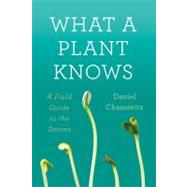
Daniel Chamovitz, Ph.D., is the director of the Manna Center for Plant Biosciences at Tel Aviv University. He has served as a visiting scientist at Yale University and at the Fred Hutchinson Cancer Research Center, and has lectured at universities around the world. His research has appeared in leading scientific journals. Chamovitz lives with his wife and three children in Hod HaSharon, Israel.
“Like us, a plant that aspires to win the rat race must exploit its environment. Even a daffodil can detect when you’re standing in its light, and a rhododendron knows when you’re savaging its neighbor with the pruning shears. With deftness and clarity, Daniel Chamovitz introduces plants’ equivalent of our senses, plus floral forms of memory and orientation. When you realize how much plants know, you may think twice before you bite them.” —Hannah Holmes, author of Quirk and Suburban Safari
“Just as his groundbreaking research uncovered connections between the plant- and animal kingdoms, Daniel Chamovitz’s insights in What a Plant Knows transcend the world of plants. This entertaining and educational book is filled with wondrous examples that underscore how the legacy of shared genomes enables plants and animals to respond to their environments. You’ll see plants in a new light after reading What a Plant Knows.” —Gloria M. Coruzzi, Carroll and Milton Petrie Professor, Center for Genomics and Systems Biology, New York University
“If you’ve ever marveled at how and why plants make the choices they do, What a Plant Knows holds your answer. Chamovitz is a master at translating the science of botany into the language of the layman.” —Michael Malice, author, subject of Ego & Hubris, and succulent enthusiast
“Chamovitz walks the Homo sapiens reader right into the shoes—or I should say roots—of the plant world. After reading this book you will never again walk innocently past a plant or reach insensitively for a leaf. You will marvel and be haunted by a plant’s sensory attributes and the shared genes between the plant and animals kingdoms.” —Elisabeth Tova Bailey, author of The Sound of the Wild Snail Eating
“What a Plant Knows is lively, eloquent, scientifically accurate, and easy to read. I commend this engaging text to all who wonder about life on earth and seek a compelling introduction to the lives of plants as revealed through centuries of careful scientific experimentation.” —Professor Stephen D. Hopper, Director, Royal Botanic Gardens, Kew
The New copy of this book will include any supplemental materials advertised. Please check the title of the book to determine if it should include any access cards, study guides, lab manuals, CDs, etc.
The Used, Rental and eBook copies of this book are not guaranteed to include any supplemental materials. Typically, only the book itself is included. This is true even if the title states it includes any access cards, study guides, lab manuals, CDs, etc.